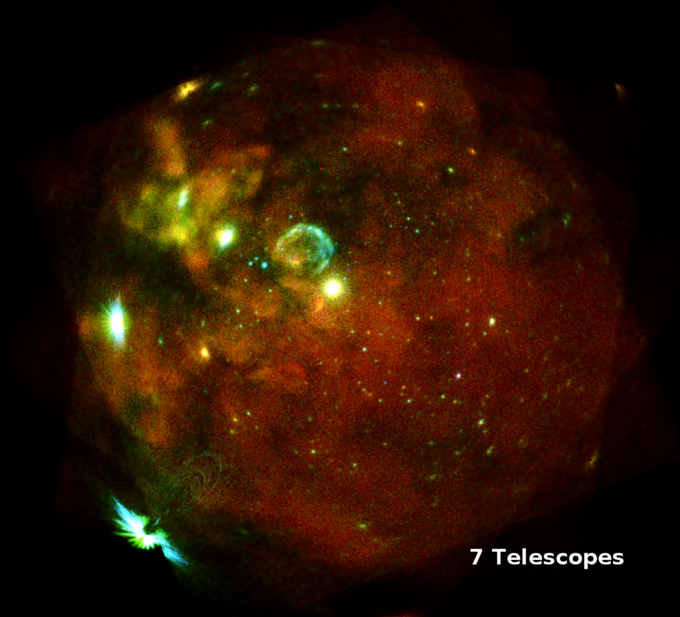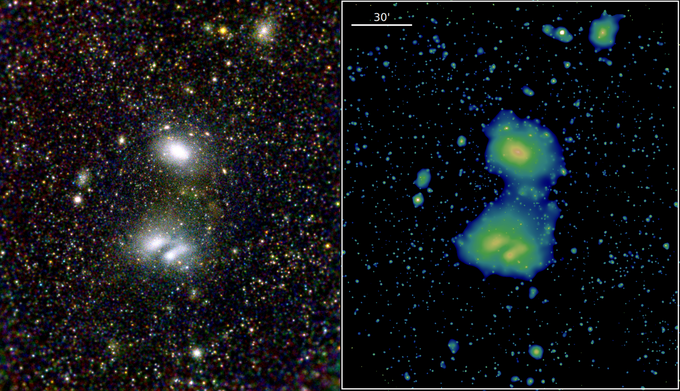German X-Ray Telescope Takes First Images of Universe. Here They Are!

The first images from a dark-energy-hunting telescope have been revealed, and they're spectacular.
On Oct. 22, 2019, the inaugural images from the German X-ray telescope eROSITA were presented to the public at the Max Planck Institute for Extraterrestrial Physics (MPE) in Bavaria, Germany. These "first light" images are a combination of pictures from all seven of the telescope's Wolter-1 mirror modules, which have been scanning the sky with custom CCD cameras.

The German space agency (DLR)'s eROSITA telescope, which has been making observations since Oct. 13, has taken combined X-ray images of pieces of the night sky. Those include pictures of the Large Magellanic Cloud (LMC) and A3391/3395, an interacting pair of galaxy clusters located about 800 million light-years from Earth.
Related: X-Ray Universe: Amazing Photos by the Chandra X-Ray Observatory
"These first images from our telescope show the true beauty of the hidden universe," Peter Predehl, principal investigator of eROSITA, said in a statement. "To meet our science goals, we needed enough sensitivity to detect the most-distant clusters of galaxies in the universe over the whole sky and resolve them spatially. These first light images show that we can do exactly that, but we can go a lot further."

Between the telescope's CCD cameras and seven mirror modules, the observatory is extremely sensitive. "The potential for new discoveries is immense. Now we can start reaping the fruits of more than 10 years of work," Predehl added.
A testament to the sensitivity of the instrument, eROSITA was able to capture some interesting details in the LMC, including remnants of the supernova SN 1987A and a number of both foreground stars and distant active galactic nuclei.
Breaking space news, the latest updates on rocket launches, skywatching events and more!
The highly sensitive eROSITA telescope will not only help scientists capture detailed images of cosmic objects like stars and diffuse gas, but it could also support the investigation of dark energy, scientists said.
"This is a dream come true. We now know that eROSITA can deliver on its promise and create a map of the whole X-ray sky with unprecedented depth and detail," Andrea Merloni, eROSITA project scientist, said in the same statement.
"The legacy value will be enormous," Meroni added. "Beside the beautiful images like the ones we're showing today, catalogues of millions of exotic celestial objects such as black holes, galaxy clusters, neutron stars, supernovae and active stars will be used by astronomers for years to come."
eROSITA, which launched with a Spektrum-Röntgen-Gamma (Spektr-RG) satellite onboard a Proton rocket on July 13, 2019, from the Baikonur Cosmodrome in Kazakhstan, is part of Spectrum Roentgen Gamma (SRG), a Russian-German collaborative astrophysical-observation mission, which includes the Russian ART-XC telescope.
- Behold! This Stunning Light Art Is Actually a Sky Filled with X-Rays
- Amazing Photos from Dark Energy Camera in Chile
- Gallery: Dark Matter Throughout the Universe
Follow Chelsea Gohd on Twitter @chelsea_gohd. Follow us on Twitter @Spacedotcom and on Facebook.
Join our Space Forums to keep talking space on the latest missions, night sky and more! And if you have a news tip, correction or comment, let us know at: community@space.com.

Chelsea “Foxanne” Gohd joined Space.com in 2018 and is now a Senior Writer, writing about everything from climate change to planetary science and human spaceflight in both articles and on-camera in videos. With a degree in Public Health and biological sciences, Chelsea has written and worked for institutions including the American Museum of Natural History, Scientific American, Discover Magazine Blog, Astronomy Magazine and Live Science. When not writing, editing or filming something space-y, Chelsea "Foxanne" Gohd is writing music and performing as Foxanne, even launching a song to space in 2021 with Inspiration4. You can follow her on Twitter @chelsea_gohd and @foxannemusic.
